PPC
The Holiday Marketing Trends & Predictions That Will Make (or Break) Your 2023 Sales

Wouldn’t it be great if we had a ghost like Ebeneezer Scrooge had to show us what was in store for the upcoming holiday season (sans the morbid undertones, of course)?
Unfortunately, we don’t have the specter of Christmas future to show us the way. But we do have lots of data from holidays past and earlier in 2023 to give us a hint at what will help us marketers get the most out of the season.
After deep diving into a lot of information, we found four themes emerge. Some are familiar. Some suggest the need for a tweak from our 2022 strategy.
Here we’ll parse through the data to see what holiday marketing trends it foretells, then offer some practical actions so you can ride their waves. No scary reaper-like apparitions needed.
Inflation is re-prioritizing discounts
The first holiday marketing trend makes a lot of sense because when the economy is less stable, consumers hold their finances a little dearer. As inflation continues at a higher rate than in previous years, that’s what we face this holiday season.
Savings are top of mind for buyers…
In a large consumer survey by Numerator, 88% of people polled said inflation will have at least some impact on their holiday spending. 67% of that cohort said their inflation-curbing strategy will be to look for big bargains (by comparison, half said they’d buy fewer items).

Our own survey of 2,000 US adults exposed a similar attitude. They told us that lower product pricing was the top incentive they’ll look for when determining where to shop.
Retailers are preparing for inflation-induced cost cutting this year. Many shops are ordering fewer high-end products and reducing inventory overall. Plus most (67%) retailers say they anticipate needing deep discounts to appease 2023 holiday shoppers.
…and you’ll need to promote savings earlier this year
In 2022, many sellers held off on offering discounts until later in the holiday buying season—often waiting until the biggest shopping days to share them. This year, Amazon may push retailers to market holiday deals earlier than ever.
In August, the world’s largest retailer announced they’d host a second Prime Day (officially called Prime Big Deals Day) in October. Amazon’s Prime Days give Prime Members exclusive access to big discounts on thousands of products.
Amazon’s gravity in retail is such that when it moves, most other sellers have no choice but to follow. “For the wider retail sector, Amazon’s decision is disruptive as it means spend will be pulled forward and the traditional calendar of discounting will be upended,” Amazon Global Data Managing Director Neil Saunders told Retail Dive.
How to lean into this trend
With consumers pinching pennies and Amazon pitching early deals, you may need to reconsider the timing and topics of your holiday promotions.
The first step is to get your holiday marketing plan set pronto since other brands and retailers are likely to jump on the early deal bandwagon.
Then, try shifting a few of your best bargains to earlier in the season. Make a huge deal out of every opportunity to save.

If discounts aren’t your thing, consider other ways to promote more value. Offer a gift card with purchase, give a trial pack when someone buys full size, or bundle products or services at a special price.
In 2023, holiday shopping gets more social
Shoppers are shifting their search for the perfect gift to social media platforms. And as they get more socially savvy, they’ll want higher-quality content and smoother buying experiences.
A social media strategy is now a must-have
Just about any data you find on the topic will show that more people are looking to the likes of Facebook and Instagram for purchase inspiration and information.
In Q1 of 2023, traffic referrals from social channels were up 27% year-over-year (source). In our survey, three out of every four shoppers said they plan to use social media to learn about products.
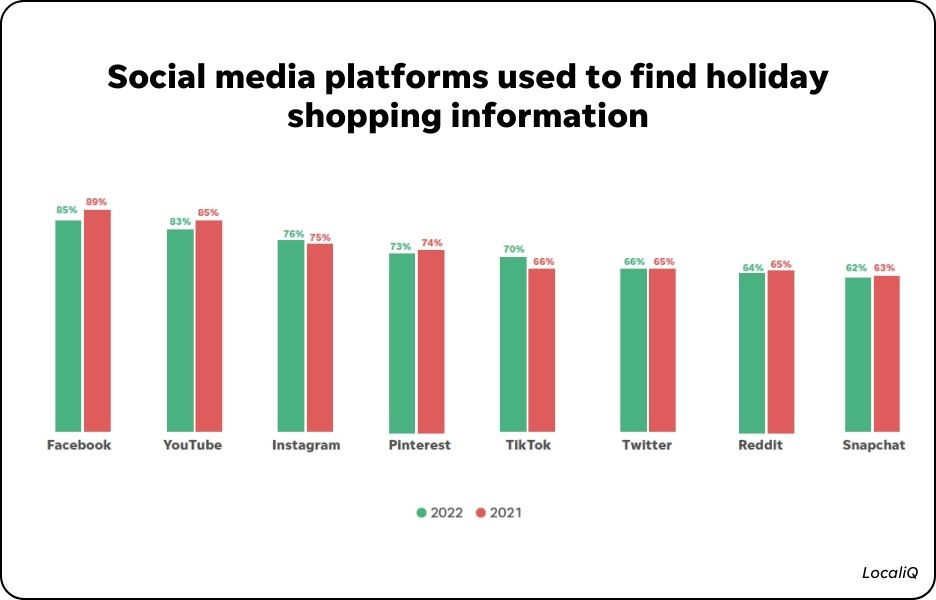
Even if you primarily sell from a physical shop, you’ll still benefit from a strong social media presence. Salesforce’s data shows that “in the past three months, more than half of consumers reported going to a physical store to see or buy products they discovered on their social feeds.”
Just how important is social media marketing this year? Advertising on social media is expected to generate 10 times more holiday visits to online shops than traditional marketing according to the same Salesforce report.
There’s a lot of growth packed into those creative holiday posts.
Video is taking the lead
In case you haven’t heard, video is pretty darn engaging. A recent HubSpot report revealed that viewers “watch nearly all short-form videos for over 40% of their duration, while 30% of videos have an average watch duration of over 81%.”
What’s even better is video’s ability to capture shoppers’ interest.
A report from last year showed that nearly half of all TikTok users said they’d bought something after seeing it on the short-form video app.

Livestream videos might be even more powerful. Rob Illidge, CEO of social media agency Social Republic, recently told us that consumers spend three times longer watching live videos than pre-recorded visual content.
Those viewers aren’t just there for the entertainment. The livestream ecommerce market is due to triple in size (reaching over $37B) in 2023.
As you might expect, younger shoppers lead the way in these new buying trends. Gen Z consumers said that other than a direct exposure to a product from friends or family, TikTok videos are the biggest influencer in their decision to make a purchase.

How to lean into this trend
Go big on social media. If you don’t have one yet, put together a social media strategy. Include a mix of organic posts and paid social ads for more targeted reach and higher conversions.

To make the purchase process easier, include some shopping posts in the mix. For example, you can sell directly on Instagram by adding shoppable tags or stickers to in-line posts, Reels, or Stories. And if you use Instagram Checkout, holiday gift buyers don’t even need to leave the platform.

If it’s not already in your strategy, give TikTok a hard look for capturing holiday sales. There are several ways to engage buyers on TikTok, including partnering with influencers, posting educational videos, and using paid ads.

Creating enough holiday-themed content will take the jingle out of anyone’s bells. Here are some sources of inspiration to make it much easier:
Shipping and return policies are the hot holiday items this year
We wouldn’t normally consider any “policy” to be marketing gold. But shoppers have said loud and clear they’ll reward brands that offer convenient delivery plus hassle-free returns with their gift-buying dollars. So put those policies on blast to meet this holiday marketing trend.
Shoppers want flexible shipping options
While holiday shoppers hunt for bargains, one target of their frugality will be shipping. Not only do they want to save on the cost of transporting their gifts, but buyers will also want a choice in how their items are delivered.
Shopkick’s 2022 holiday survey showed that free shipping was the primo perk gift-givers look for when contemplating purchases. In fact, an overwhelming 91% of consumers confirmed that in the report.
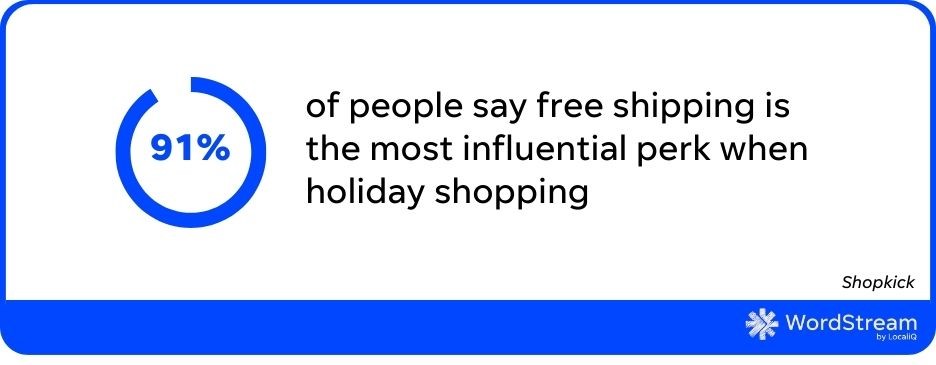
Buy online, pickup in-store (BOPIS) is another key benefit buyers will demand. BIPOS became a household term in 2020 as retailers scrambled to operate under heightened safety protocols. The convenience of shopping online coupled with the instant gratification of picking up immediately was a big hit.
This year, Salesforce’s holiday report says that 39% of consumers will seek out retailers that offer BOPIS as an option. It also showed that retailers offering BOPIS grew seven times faster than competitors that didn’t. A 700% increase in growth would make even Scrooge smile.
Buyers need confidence in return policies
Maybe it’s tied to the need to protect finances, but it’s never been more important to promote your company’s return policy (assuming it’s a good one).
The Salesforce report showed that 93% of consumers research a brand’s return policy before choosing who to buy from. And 78% of shoppers walk away from their shopping cart if they can’t return the products for free. The moral is, if you want return customers, let them return purchases.
How to lean into this trend
Fast, free, and flexible shipping are likely table stakes for converting holiday shoppers in 2023. On the marketing front, it’ll be important to get the message out that your company offers those things.
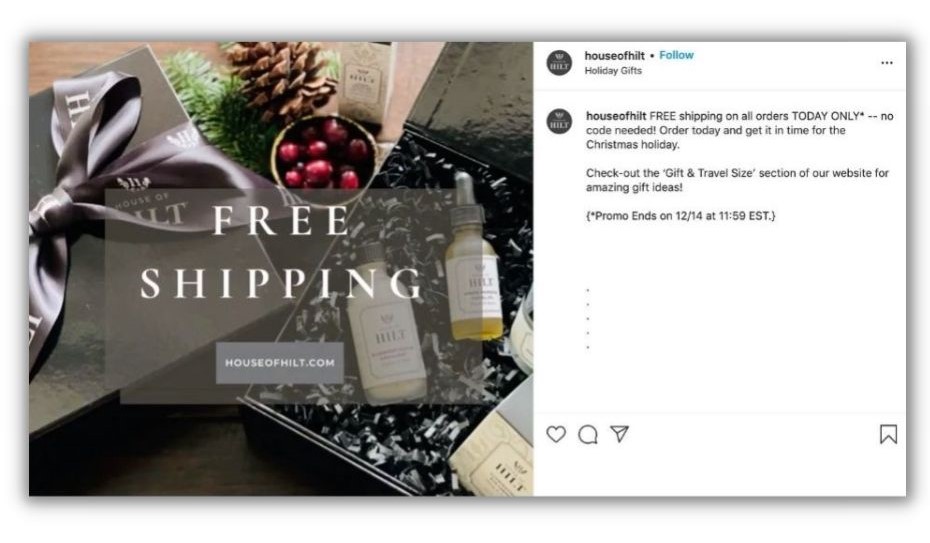
And while your return policy may seem as dry as Aunt Edna’s fruit cake, don’t be afraid to make it the star of a few holiday promotional posts. That goes doubly true for seasonal emails that keep current customers and brand fans from looking elsewhere while they check off their gift lists.
Authenticity and purpose will be keys to Gen Z holiday marketing
Gen Z is becoming a holiday shopping force that deserves your attention.
Why? Because:
They’re also the most diverse generation in history and are less likely to be influenced by slick marketing. So if you want to connect with this large population of enthusiastic holiday shoppers that care more about brand than price, authenticity, and diversity are the name of the game.
Looking for the real deal
Every generation wants relevance and authenticity. Gen Z has the technical savvy to know how marketers deliver that online and are willing to accept the tradeoffs.
Research from Tinuiti, for example, noted that Gen Zers are three times more likely than older generations to say yes to Apple’s App Tracking Transparency prompts (and other tracking prompts like it). They’re also much less likely to clear their browser cookies or use ad-blocking technology.

In exchange for being followed online, the youngest adult generation expects marketing that’s more down-to-earth and relevant. “My company’s survey showed that Gen Z valued honesty and straightforwardness more than any generation since their grandparents and great-grandparents (The Silent Generation),” Nishat Mehta, President of IRI Media Center of Excellence, wrote in Forbes.
So while Gen Zers still respond well to influencers—Marketing Dive’s report said 75% of those surveyed have purchased a product in the last year based on an influencer’s recommendation—they better be relevant. Younger buyers are more likely to respond to a micro-influencer that lives like them versus a high-profile celebrity.
Marketers play a direct role in establishing their brand as authentic, too. Three-quarters of Gen Zers want brands to respond to feedback (and believe this qualifies the brand as authentic).
Diversity is queen
Many studies, like the one from Creatopy, prove that Gen Z wants brands to take a stand on social issues.
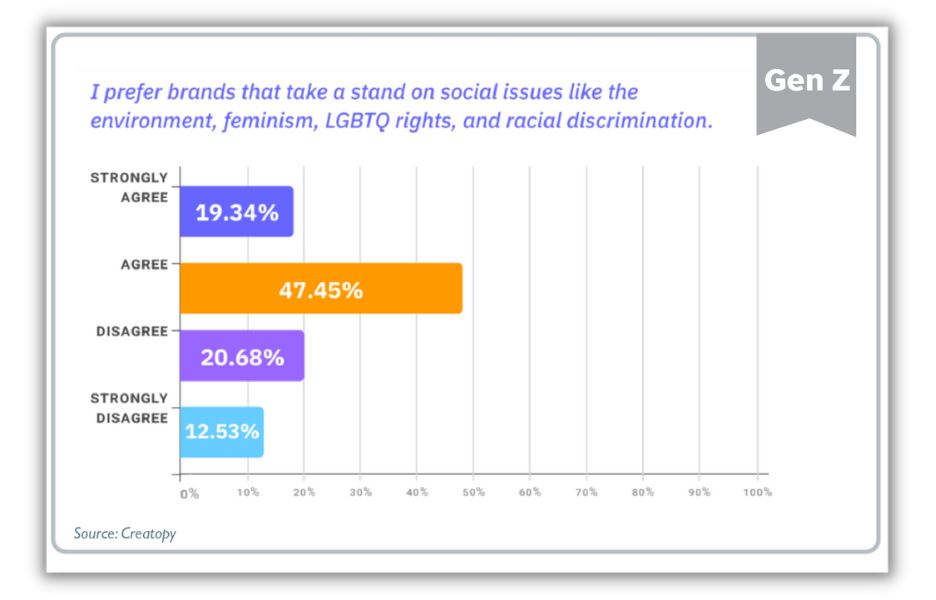
And since Gen Z is the most diverse generation in history, you can expect diversity and inclusivity to be high on the list of topics they want brands to support.
Data from Pew Research backs it up. It showed that more than other generations, Gen Zers see racial and ethnic diversity as a net positive for society (although Millennials are not far behind).
How to lean into this trend
For starters, if you don’t have an influencer marketing strategy, you may want to consider one. Even if it’s just one or two influences who can share things like gift guides. Just make sure you choose influencers that will be relevant to your Zoomer audience. No flashy celebrities, just people who live and speak like the people you’re trying to connect with.
Next, be available to connect with Gen Z shoppers directly. That means replying to social media comments and responding to reviews.
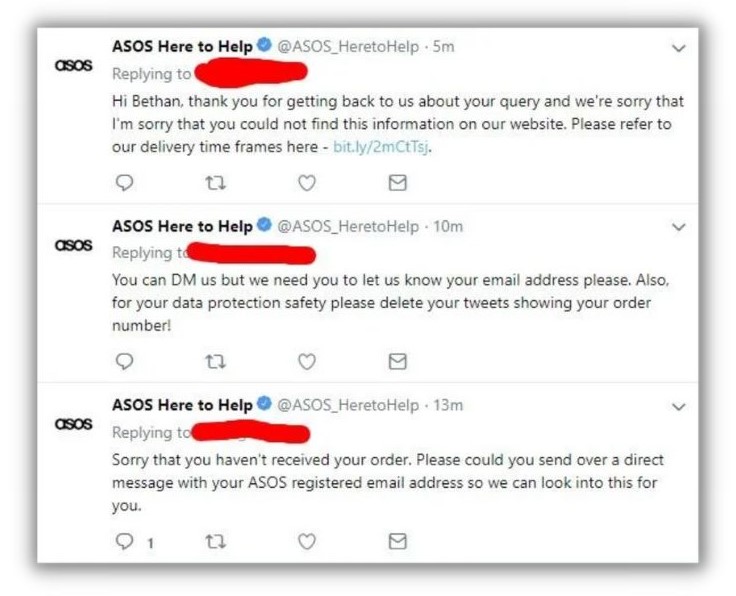
Create a holiday referral program to get more of the word-of-mouth recommendations Gen Z covets.
Since Gen Z is so diverse, they’re more likely to celebrate several different traditions. Review a holiday diversity calendar to see when to promote various events.
You’ll find there are many faith, cultural, and cause-based holidays to discuss. The trick is to be authentic about your holiday messaging.

Your images should include a variety of people. Ethnicity is a good start, but think about representing people with different abilities as well.

That type of representation will mean a lot to people who identify with the image and with the conscientious Gen Z as a whole.
While some of these strategies aren’t specific to the holidays, they will make your brand more attractive and relatable to Zoomers while they look to fill their loved ones’ stockings.
We predict these 2023 holiday marketing trends will make your season brighter
No one can tell the future. But we can learn from the past. With a little insight from shopper behavior earlier this year and from recent holidays, you’ll have a chance at being the brand buyers want you to be.
To make the most of the upcoming holiday season, remember:
- Promote discounts loudly and early
- Go heavy on organic and paid social media
- Include shipping and return policies in your marketing messages
- Engage Gen Z with authenticity and diversity

















